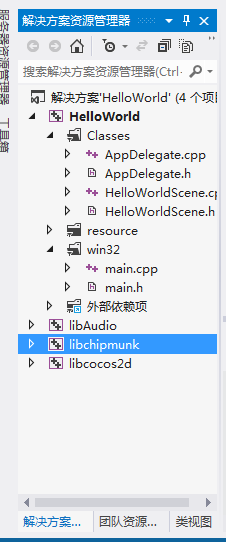打开上一篇博客中的HelloWorld工程后,会看到下图所示的工程文件
main.cpp文件中的代码(本人已经注释)
#include "main.h"
#include "AppDelegate.h"
#include "cocos2d.h"
//命名空间
USING_NS_CC;
//Cocos2d-X的主函数(相当于C/C++中的main函数)
int APIENTRY _tWinMain(HINSTANCE hInstance,
HINSTANCE hPrevInstance,
LPTSTR lpCmdLine,
int nCmdShow)
{
//表示lpCmdLine、nCmdShow是两个没用的参数
UNREFERENCED_PARAMETER(hPrevInstance);
UNREFERENCED_PARAMETER(lpCmdLine);
//定义一个app对象
AppDelegate app;
//执行app对象的run函数。进入帧循环
return Application::getInstance()->run();
}
main.cpp中的代码只是实现了下面的操作
1、定义一个App对象
5、执行App对象进入帧循环
注释:其中程序中真正重要的是最后一行代码中的run函数,run函数在后面的游戏开发中起到了至关重要的作用
AppDelegate.cpp文件中的代码(本人已经注释了)
#include "AppDelegate.h"
#include "HelloWorldScene.h"
//命名空间
USING_NS_CC;
//构造函数
AppDelegate::AppDelegate() {
}
//析构函数
AppDelegate::~AppDelegate()
{
}
//程序启动完成后会进入的函数
bool AppDelegate::applicationDidFinishLaunching() {
//初始化导演
auto director = Director::getInstance();
//获得OpenGL视图
auto glview = director->getOpenGLView();
//如果没有获取OpenGL视图
if(!glview)
{
//创建OpenGL视图
glview = GLView::create("My Game");
//设置OpenGL视图
director->setOpenGLView(glview);
}
//设置是否显示调试信息
director->setDisplayStats(true);
//设置帧率
director->setAnimationInterval(1.0 / 60);
//调用场景
auto scene = HelloWorld::createScene();
//执行场景
director->runWithScene(scene);
return true;
}
//当程序进入后台后调用的函数(当在玩游戏时忽然别人打来电话时,程序进入后台)
void AppDelegate::applicationDidEnterBackground() {
//停止播放动画
Director::getInstance()->stopAnimation();
//暂停播放背景音乐
//SimpleAudioEngine::getInstance()->pauseBackgroundMusic();
}
//当程序重新被激活的时候调用的函数(声音重新响起)
void AppDelegate::applicationWillEnterForeground() {
//播放动画
Director::getInstance()->startAnimation();
//继续播放背景音乐
//SimpleAudioEngine::getInstance()->resumeBackgroundMusic();
}
1、初始化导演类
2、获取以前创建的OpenGL视图
3、如果没有获取到OpenGL视图,重新创建OpenGL视图
4、设置openGL视图
5、设置是否显示调试信息
5、设置动画的帧数
6、调用场景(游戏真正的开始)
7、执行场景
HelloWorldScene.h中的代码(本人已经注释)
#ifndef __HELLOWORLD_SCENE_H__
#define __HELLOWORLD_SCENE_H__
#include "cocos2d.h"
//HelloWorld类继承自Layer类
class HelloWorld : public cocos2d::Layer
{
public:
//创建场景
static cocos2d::Scene* createScene();
//初始化层
virtual bool init();
//菜单响应函数
void menuCloseCallback(cocos2d::Ref* pSender);
//用于创建:场景、菜单、层等东西
CREATE_FUNC(HelloWorld);
};
#endif
HelloWorldScene.cpp中的代码(本人已经注释)
#include "HelloWorldScene.h"
//命名空间
USING_NS_CC;
//创建场景
Scene* HelloWorld::createScene()
{
//创建场景
auto scene = Scene::create();
//创建层
auto layer = HelloWorld::create();
//将层添加到场景中
scene->addChild(layer);
//返回场景
return scene;
}
//初始化层
bool HelloWorld::init()
{
//初始化父类的Layer
if(!Layer::init())
{
return false;
}
//获得窗口的大小
Size visibleSize = Director::getInstance()->getVisibleSize();
//获得坐标原点的坐标
Vec2 origin = Director::getInstance()->getVisibleOrigin();
//用图片创建菜单项
//第一个参数:正常状态下的图片
//第二个参数:被选中时的图片
//第三个参数:响应函数
auto closeItem = MenuItemImage::create(
"CloseNormal.png",
"CloseSelected.png",
CC_CALLBACK_1(HelloWorld::menuCloseCallback, this));
//设置菜单项的位置
closeItem->setPosition(Vec2(origin.x + visibleSize.width - closeItem->getContentSize().width/2 ,
origin.y + closeItem->getContentSize().height/2));
//创建菜单
auto menu = Menu::create(closeItem, NULL);
//设置菜单的坐标原点为左下角(菜单中默认的坐标原点在窗口的中央)
menu->setPosition(Vec2::ZERO);
//将菜单项添加到菜单中
this->addChild(menu, 1);
//创建一个标签
//第一个参数:标签中的内容
//第二个参数:字体
//第三个参数:字体大小
auto label = LabelTTF::create("Hello World", "Arial", 24);
//设置标签的位置
label->setPosition(Vec2(origin.x + visibleSize.width/2,
origin.y + visibleSize.height - label->getContentSize().height));
//设置标签的位置
this->addChild(label, 1);
//创建一个精灵
auto sprite = Sprite::create("HelloWorld.png");
//设置精灵的位置
sprite->setPosition(Vec2(visibleSize.width/2 + origin.x, visibleSize.height/2 + origin.y));
//将精灵添加到层中
this->addChild(sprite, 0);
return true;
}
//菜单响应函数
void HelloWorld::menuCloseCallback(Ref* pSender)
{
#if (CC_TARGET_PLATFORM == CC_PLATFORM_WP8) || (CC_TARGET_PLATFORM == CC_PLATFORM_WINRT)
MessageBox("You pressed the close button. Windows Store Apps do not implement a close button.","Alert");
return;
#endif
//结束场景
Director::getInstance()->end();
#if (CC_TARGET_PLATFORM == CC_PLATFORM_IOS)
exit(0);
#endif
}
HelloWorldScene.cpp中的代码中的CCScene* HelloWorld::scene(),实现了创建场景的过程:
1、创建场景
2、创建层
3、将层加到场景上
4、返回场景
HelloWorldScene.cpp中的代码中的CCScene* HelloWorld::init(),实现了初始化实例:
1、初始化父类的Layer
2、得到窗口的大小
3、得到窗口的坐标
4、创建菜单项
5、设置菜单项的位置
6、设置菜单的位置
7、将菜单加到层中
8、创建标签
9、设置标签的位置
10、将标签加到层上
11、创建精灵
12、设置精灵的位置
13、将精灵加到层上























 1357
1357

 被折叠的 条评论
为什么被折叠?
被折叠的 条评论
为什么被折叠?








